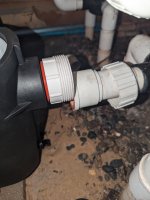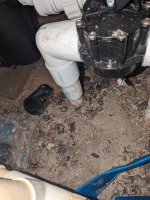So my new Calimar 3HP finally got here, and I was just crossing my fingers that the plumbing would work, but it doesn't. The suction side is about an inch higher, and the pressure side is just a smidge different. The pressure side I think I can just get a new 1.5 inch union for my multiport side and build back to where I have some space in the run to join to the existing 2 inch pipe, but I might need another 2 inch union. Anyway, that's all fine and reachable.
For the suction side though, I'm not sure what to do. Everything is really tight with the valves and lots of old repairs taking all the virgin pipe. I can't see where I can insert anything to raise the entire valve set up the inch I need. What are my options here? I guess I can dig underground and find virgin stuff below the T and below the dirt on the two skimmers and work from there, but that sounds annoying. I could just extend the 2inch suction side with a union instead of the pump, but I only have about nine inches behind the pump before my heater, and I need to leave air space, so I might only have 6 inches to work with, which I don't think is enough to make that happen. Ideas?





For the suction side though, I'm not sure what to do. Everything is really tight with the valves and lots of old repairs taking all the virgin pipe. I can't see where I can insert anything to raise the entire valve set up the inch I need. What are my options here? I guess I can dig underground and find virgin stuff below the T and below the dirt on the two skimmers and work from there, but that sounds annoying. I could just extend the 2inch suction side with a union instead of the pump, but I only have about nine inches behind the pump before my heater, and I need to leave air space, so I might only have 6 inches to work with, which I don't think is enough to make that happen. Ideas?










